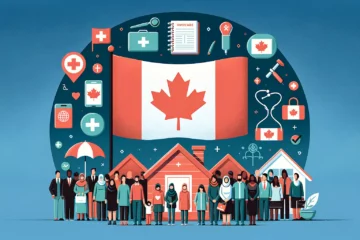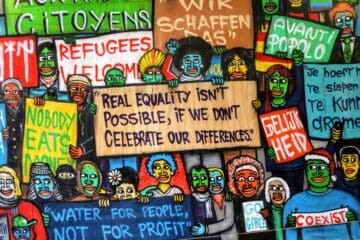Canada is among the top countries that have programs in place to help refugees from around the globe. The Canadian refugee system accepts any asylum seekers who have fled their own country on account of serious human rights violations, or who are unable to return home and are in dire need of protection.
Canada via the Immigration, Refugees and Citizenship Canada’s (IRCC) has welcomed more than 1,000,000 refugees since 1980. At the end of 2021, the refugee population accounted for 14.74 percent of all permanent residents in Canada.
The current state of refugees in Canada
UNHCR ranks Canada as one of the countries that host many refugees worldwide. Ahead of World Refugee Day last year, the Canadian Government announced more plans to expand the admission of refugees and their families and expedite their applications for permanent residency.
Canada is open to welcoming as many refugees as the country can hold. The IRCC has recently released a revised target of over 431,000 immigrants in 2022. This is part of Canada’s 2022-2024 Immigration Levels Plans, and sets out a path for increases to immigration targets to help the Canadian economy recover and to fuel post-pandemic growth. Over half of all planned admissions are in the Economic Class category which outline a path to increase immigration targets to propel the post-pandemic economic recovery.
Since August 2021, Canada has welcomed more than 15,000 Afghan refugees as per June 2022 figures. In 2018, Canada was also ranked as the country with the highest refugee resettlements globally.
How to gain refugee status in Canada
Like most countries, Canada only welcomes refugees on a referral basis. You cannot apply to become a refugee directly to the Canadian Government. The Government, through IRCC, requires the refugee to be referred by another party upon fulfilling all requirements for a refugee.
The United Nations Refugee Agency (UNHCR) is the primary designated referral organization. Other private sponsorship groups, as discussed below, can also refer you to Canada. A refugee must belong to one of these two refugee classes to receive the referral.
1. Convention Refugee Abroad Class
People belonging to this class should meet the following conditions:
- They live outside their home countries.
- They cannot return to their home countries due to fear of persecution based on race, religion, political opinion, membership in a particular social group, etc.
2. Country Of Asylum Class
Those belonging to this refugee class must fulfill these conditions:
- They live outside their mother country or country of residency.
- They must also have been seriously affected by civil war or experienced an enduring fundamental human rights violation.
The Canadian Government will also welcome any refugee (under both classes), provided they can financially support themselves and their families. However, you’ll still need a referral from the UNHCR, an accredited referral organization, or a private sponsorship group.
Canada Refugee Protection Programs
The Canadian refugee system works in two ways:
1. Refugee and Humanitarian Resettlement Program
The Refugee and Humanitarian Resettlement Program serves people who need protection from outside Canada during the time of application. As per the provisions of the Canadian Refugee protection programs, the United Nations Refugee Agency (UNHCR) is the only agency that can identify eligible refugees for resettlement.
Canada also boasts a network of private sponsors across the country allowed to resettle refugees to Canada on an ongoing basis. They are classified into the following groups:
The Sponsorship Agreement Holders
These are religious, ethnic or community organizations with signed sponsorship agreements from the Canadian Government to support refugees. They can sponsor the refugees directly or partner with other community members.
Groups of Five
This consists of at least five adult Canadian citizens/permanent residents who agree to sponsor and accommodate a refugee within their local community. Groups of Five provide the refugee with a settlement plan and financial support for up to a year.
Community Sponsors
Community sponsors can be organizations or corporations which sponsor refugees with a settlement plan and financial support for up to one year.
These groups of private sponsors can meet these refugees via:
- The Blended Visa Office-Referred (BVOR) Program – The program partners refugees that the UNHCR has identified with a sponsor in Canada.
- People in churches, local communities, ethnocultural groups, etc.
Under Canadian laws, all refugees must be adequately vetted for any criminal offences or health conditions regardless of their sponsors or resettlement program. The IRCC also expects refugees who come to Canada to be people without homes and have lived in refugee camps for years before seeking resettlement.
How To Apply for Refugee Status Under the Canada Refugee and Humanitarian Resettlement Program
Persons seeking refugee status can find a complete application package on IRCC’s site. The application packages comprise all the necessary forms to apply for refugee resettlement under this program, such as:
- A form about the refugee background
- A form for Additional Dependents
- Refugees Outside Canada form
- A form on whether the refugee used a representative
If the UNHCR or another referral organization refers the refugee, the IRCC abroad will guide them on how to apply to their office. They’ll email the refugee a confirmation letter along with an assigned file number. If the application is accepted, the IRCC will decide where to resettle the refugee.
Any refugee referrals by a private sponsor group will require the group handling the referral to apply to the IRCC. If the application is accepted, the refugee will be resettled to the region where their sponsor resides.
In both circumstances, the IRCC will collaborate with the partners to arrange for the refugee’s transportation and settlement. There are no fees charged throughout the application process.
2. In-Canada Asylum Program
Canada also has the In-Canada Asylum Program for people making refugee protection claims from within the country. The program works to provide refugee protection to those who fear for their persecution, torture or cruel punishment in their home countries.
The In-Canada Asylum refugee program is strict, and most people are denied asylum status on conditions like:
- A previous conviction for a serious criminal offence
- Denial of previous refugee claims
Canada’s Immigration and Refugee Board (IRB) decides whether or not a person meets the conditions to be granted refugee status under the In-Canada Asylum program.
Claiming Refugee Status in Canada
A person can make refugee claims in Canada or outside Canada in the following ways.
Refugee Claim via Port of Entry
The Canadian Government allows refugees to make protection claims upon arriving in Canada at ports of entry like airports, land borders or seaports. The person will be required to complete an eligibility interview with an officer from the Canada Border Services Agency (CBSA).
An ‘eligible’ claim will be referred to the Immigration and Refugee Board of Canada (IRB) for a hearing. A refugee claim may be disqualified if:
- The applicant had previously made a refugee claim in Canada
- The refugee has committed a serious criminal offence in the past
- The refugee entered Canada via the United States.
Eligible refugees are granted forms by a CBSA officer to complete during the interview. The officer will also provide a Basis of Claim Form (BOC), which must be submitted for each refugee family member within 15 days after the claim was referred.
Refugees with qualified claims are eligible for:
- Access to Canada’s Interim Federal Health Program and other services. They’ll be granted a Refugee Protection Claimant Document for the same.
- A Confirmation of Referral letter confirms the claim has been referred to the IRB.
Making a claim after arriving in Canada
A refugee protection claim made after arriving in Canada requires the claimant to submit a complete application, including all supporting documentation and the BOC Form. The claim must be submitted online through the Refugee Protection Portal. The essential requirements here are electronic copies of documents and an online account to submit the claim
Refugees unable to submit their claims online after arriving in Canada can request to offer the same on paper from inside Canada. Alternatively, they can work with a representative based in Canada to help complete and submit the claim on their behalf.
How long does it take a refugee to get to Canada after their sponsorship Is approved?
It may take up to 16 weeks for a refugee to arrive in Canada after their refugee sponsorship in the country is approved. The stages involved before travelling are;
- One week of processing the sponsorship application
- Eight weeks for the refugees to get their visas and exit permits, depending on their location
- Three to six weeks for refugees to get their travel documents
Other factors like an unexpected change in the situation in the refugee’s country can also delay travel to Canada.
Final thoughts
Canada’s refugee programs remain one of the best in the world, thanks to the country’s willingness and well-laid plans to accept more asylum seekers. The Government of Canada also collaborates closely with many partners and stakeholders to provide different settlement services that help refugees adjust to life in Canada.
Resources
Resettle in Canada as a refugee
Applying as a Convention Refugee or as a Humanitarian—Protected Person Abroad
How Canada’s refugee system works
How do I apply for Asylum?
Claiming refugee protection – 1. Making a claim
[/et_pb_text][/et_pb_column][/et_pb_row][/et_pb_section]



0 Comments